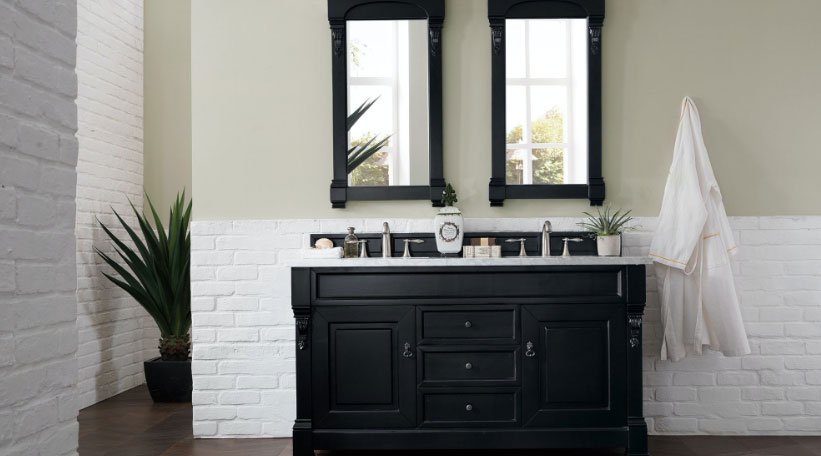Black is a trending color but in the right doses.
By Tammy Adamson-McMullen
Bright flower-power colors are associated with the 1960s, but black was all the rage, too. Blacklights, black-flocked wallpaper, black and white pop art, black wrought iron and flat black wall paint were also popular and in both residential and commercial design. The look was groovybut didn’t last too long, maybe because black in large doses is difficult to consume.
Sixty years later, the popularity of black has returned. But this time it may have more staying power as we’re using the color with a little more discretion and a lot more decorating savvy. We’re employing it as an accent color in some cases, as a highlight color in other casesand in large doses in only those areas where it’s well suited.
If you’re considering adding black to your color scheme, here are some ways to do it effectively.
Trim
Black is a stunning color for interior trim and can help to frame walls and architectural features. Like white, black has many permutations, from charcoal to ink to onyx, and some blacks even have a hint of color, like blackwatch (black with a touch of green) and midnight blue. Depending on the shade you choose, you can use black as a trim color with walls that are both cool and warm in color. Either way, you’ll create a look that is dramatic as well as sophisticated. Painting window encasements—both inside and outside—looks particularly elegant, as do black-painted mantles, fireplace surrounds and crown molding.
Accents
Black also looks sophisticated as an accent. In wallcovering, fabric and rug patterns, black is trending both as a background color and as an outline around other colors within the pattern. The addition of black makes the colors and patterns pop! and gives them some grounding. Other popular black accoutrements include lighting fixtures, picture frames and decorative pillows. Even in small doses, the inclusion of black accents adds a note of elegance to a space and makes it look on-trend. One of the most popular black accents—as in the 1960s—is black wrought iron pieces, from flat-black pieces to those with intricate scrollwork. You can expect this look to continue throughout 2020.
Cabinets
One place where black really shines is on cabinetry. Black has become one of the most desired cabinetry colors in kitchens and baths and in all sorts of gloss levels, from flat black to soft satins to highly enameled looks. Whatever the shade or finish, black cabinets work with any style of décor. In glossier finishes, blackcabinets look extremely high-end and sophisticated; in flatter finishes, they look cozy and informal. Black cabinets look especially stunning in rooms whose walls are a soft neutral color, providing just the right amount of punch. They also can help to tone down more colorful rooms or those that have a lot of pattern. Black cabinets also work beautifully with the full range of trending metals in faucets, knobs, pulls and other hardware. This is a look where you can’t go wrong!
Feature Walls
A feature wall that’s painted in black canadd the perception ofextra dimension. If painted on the far wall of a room, a black feature wall will visually lengthen or widen the space, depending on whether the room is horizontally or verticallyaligned. Black feature walls also can help to highlight whatever they surround, like a flat-screen TV, a collection of photographs, a prized painting or a fireplace. They additionally are good at absorbing glare and harsh light. In all of these cases, black serves asa supporting color in a spaceand not the star.
Star Player
That being said, black also can be the star when two or more walls in a space are painted in the color. To avoid color fatigue, it’s important to choose a shade of black shade you can live withand in a soft finish, like satin. You also might need to brighten the effect with a lighter trim color, wainscoting in a neutral shade, warm wood or tile floors, or more colorful accents. Not every room is conducive to bigger doses of black, but some are perfect for this type of treatment, including mediarooms, game rooms, dens and large, airy spaceswhere the color doesn’t feel so restrictive.
If you’re still not sure about adding black to a space, try including a pair of black pillows to the existing decorative pillows on your sofa, toss a black throw on the back of a chair or add black linens to your table setting. This is an expensive way to see the dramatic difference black can make to a space and might spur you on to add more doses of the color.

 Interior Paints
Interior Paints Exterior Paints
Exterior Paints Primers
Primers Stains & Clears
Stains & Clears
 Paint Brushes
Paint Brushes Paint Roller
Paint Roller Paint Trays & Liners
Paint Trays & Liners



